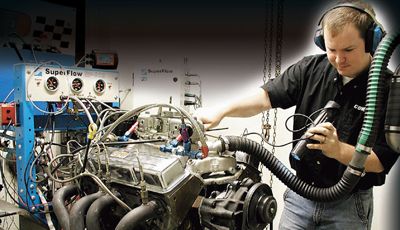
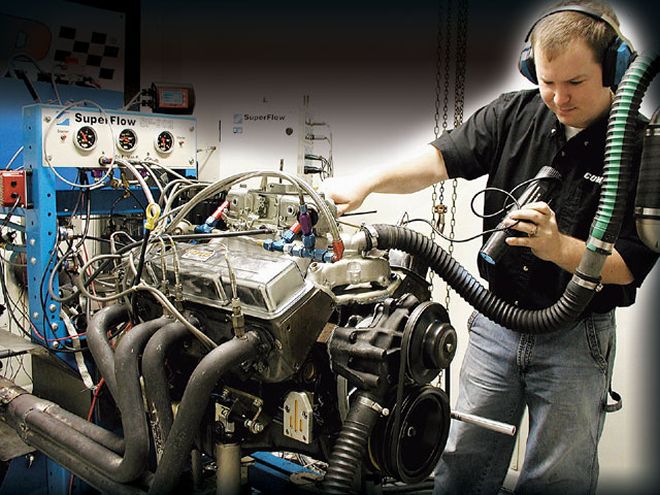 The building block for great things. The ZZ4 short-block from GM Performance Parts is the perfect platform for generating reliable street power.
The building block for great things. The ZZ4 short-block from GM Performance Parts is the perfect platform for generating reliable street power.
Walk down any row of the local car show and you will probably see a vehicle powered by General Motors' now venerable ZZ4 crate engine. The classic small-block ZZ4 is a quality built 350ci engine rated at 355 hp and 405 lb-ft of torque. To anyone looking for simple turnkey performance and a great building block for further power modifications, the ZZ4 has become the small-block Chevy of choice. Perhaps the best part of the ZZ4 is not simply its reasonably priced performance (a turnkey ZZ4 crate typically costs under $4,900), but its response to classic engine upgrades. Delivered with an aluminum dual-plane intake manifold, HEI distributor, 770-cfm vacuum-secondary carb, cast-iron water pump, damper, and flex plate, you just need to add fuel and air, then twist the key. But for the performance fan looking to really turn up the heat, there are a few things that can quickly garner almost 100 extra horsepower without a great deal of effort.
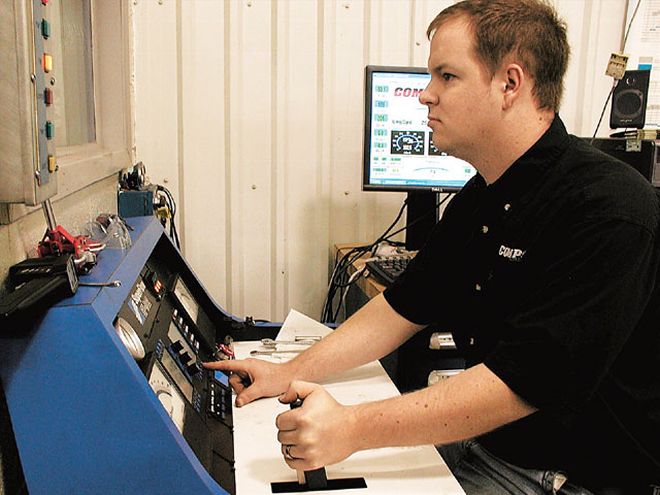 All of the tests were performed at COMP Cams' R&D center using a SuperFlow dyno. A range of component tests was performed in an attempt to create the five-stage program shown here.
All of the tests were performed at COMP Cams' R&D center using a SuperFlow dyno. A range of component tests was performed in an attempt to create the five-stage program shown here.
Setting the Stage
To test our theory about the responsive nature of the ZZ4 as a performance platform, we began by taking baseline dyno numbers on the engine. The 355hp rating and 405 lb-ft of torque are great street performance figures, but was that the real performance generated? Equipped with a Demon 650-cfm double-pumper carb (to free us of the vacuum secondaries) and 1 3/4-inch Super Comp headers, we pulled a few levers on the SuperFlow dyno, and read the charts.
After a number of adjustments for jetting and timing, our best numbers were 344 hp and 390 lb-ft of torque, a difference of 11 hp and 15 lb-ft of torque from the advertised numbers (which were spec'd with the larger 770-cfm crate motor carb). For the purpose of comparison, we will use these figures to determine the power gains from our component changes.
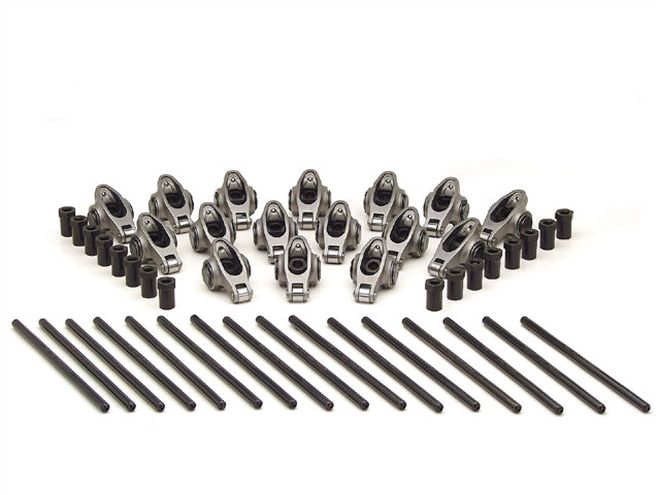
Stage 1
The various stages to be outlined here build greater horsepower by adding a specific combination of performance parts. Stage 1 is a mandatory stage for the build of our ZZ4. All other stages require that this stage be completed before the others are performed. While other stages can be selected independently (i.e., you can go right to Stage 5 and add both the cam and heads without completing stages 2-4), that is not the case with Stage 1.
To improve the basic platform, we scrutinized the parts most often considered the weakest links in terms of lost engine power and durability. Pushrods are always suspect, and in the case of our engine, we knew from previous testing that the factory units were weak, which results in a quick loss of full cam lift due to pushrod flex. To fix the problem, we installed COMP Magnum pushrods. These one-piece pushrods feature .080-inch wall chrome-moly steel tubing, and are heat-treated for added strength. A COMP pushrod length checker was used to ensure we had the correct length for our application.
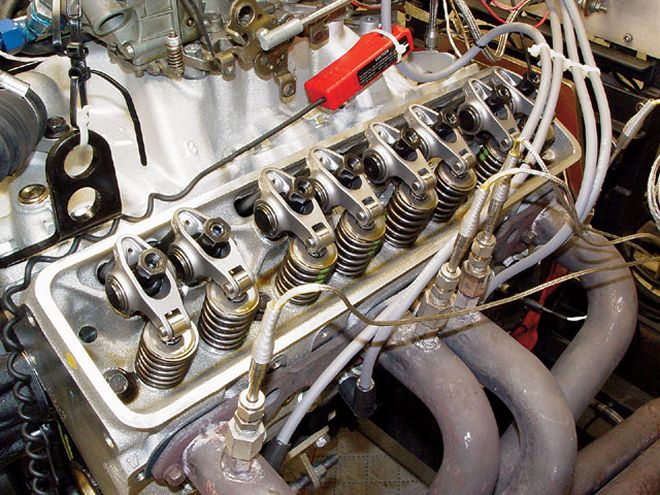 Stage 1 of the ZZ4's upgrade program is the installation of Pro Magnum rockers and Magnum pushrods.
Stage 1 of the ZZ4's upgrade program is the installation of Pro Magnum rockers and Magnum pushrods.
Our second step was to change to COMP Pro Magnum rocker arms. These rockers are made from 8650 chrome-moly steel, and feature lightweight construction with a full roller design and roller tip. We replaced the factory 1.5:1 rocker arms and tested the engine with the new parts in place. The result: 16 additional horsepower and 10 additional lb-ft of torque.
As part of our experimentation process, we also tested the engine with different ratio Pro Magnum rockers. We installed the 1.52:1 ratio exhaust Pro Magnum rockers and 1.6:1 ratio for the intake valves. It should be noted that the 1.52:1 ratio rockers are COMP's stock replacement ratio; a slight ratio increase from the factory SBC 1.5 ratio has been proven by COMP engineers to improve performance and reliability without any negative side effects. The result is a total of 20 hp and 15 lb-ft of torque over the stock figures. The use of the 1.6:1 rocker arms on the exhaust side was considered, but after measuring for coil bind, it was determined that this would not be acceptable for our street-driven engine.
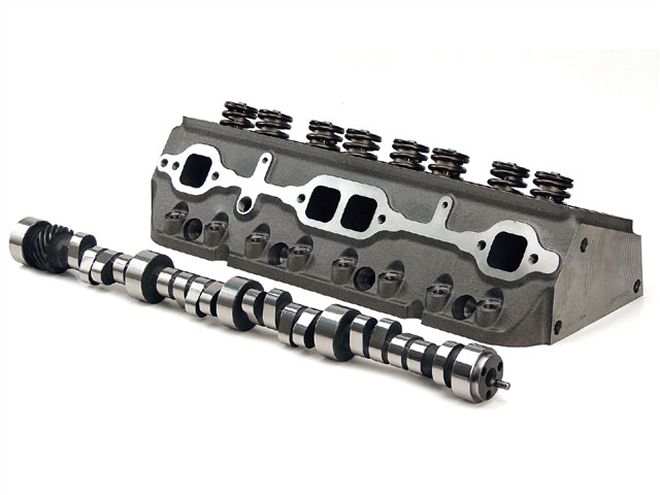 The swap to the Pro Action cast-iron cylinder heads delivered the greatest horsepower increase.
The swap to the Pro Action cast-iron cylinder heads delivered the greatest horsepower increase.
Pick A Stage
Stages 2-5 all build power over the level achieved in Stage 1. The only other component change beyond the parts listed below was the installation of a higher-flowing Edelbrock Air Gap intake, which was done to take full advantage of the camshaft's increased flow. The 650-cfm Demon carburetor was also retained, although some jetting was required to optimize the performance of the engine.
Stage 2 features an obvious and typical engine-builder upgrade: the installation of a COMP cam. Our choice for this engine was a Thumpr camshaft. This new line of COMP hydraulic roller cams uses cutting-edge camshaft technology to deliver both great performance and excellent sound from the ZZ4. We're no strangers to the Thumpr cam line. You might recall that we dropped a Big Mutha Thumpr (the largest in the lineup) into our 496-inch big-block Chevy two months ago. These specially designed camshafts feature a combination of early exhaust valve opening, long exhaust duration, and a generous amount of overlap. The installation is a simple drop-in procedure, requiring COMP hydraulic roller lifters, which slip into the stock lifter bores without modification to the bore or the lifter.
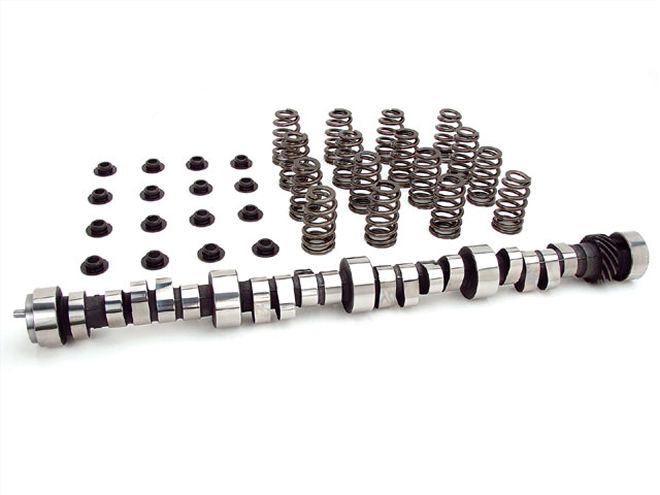 For Stages 2-5, two different Thumpr camshafts were used: the Thumpr, and the Mutha Thumpr, which features slightly larger specs than the first (see sidebar).
For Stages 2-5, two different Thumpr camshafts were used: the Thumpr, and the Mutha Thumpr, which features slightly larger specs than the first (see sidebar).
A key to making this swap is the installation of COMP Beehive valvesprings and retainers. These springs are specially built to work with the Thumpr cam's aggressive lobe design, and they deliver great performance with lower-than-usual seat pressure and extended durability. The steel retainers used in this test were an added bonus, their reduced mass makes them comparable in mass to titanium retainers on a standard diameter valvespring. It should be noted that these springs were used for both of the cylinder heads used in Stages 4 and 5.
In Spintron testing, Beehive springs have proven to deliver a host of performance and durability improvements, not the least of which include reduced valvetrain weight and increased valvetrain stability. These single-coil, ovate wire springs feature reduced spring seat pressure for better valve control. Additionally, they retain durability for on-street driving, and can also handle more rpm and aggressive cam profiles (up to approximately .600-inch lift) for racing conditions.
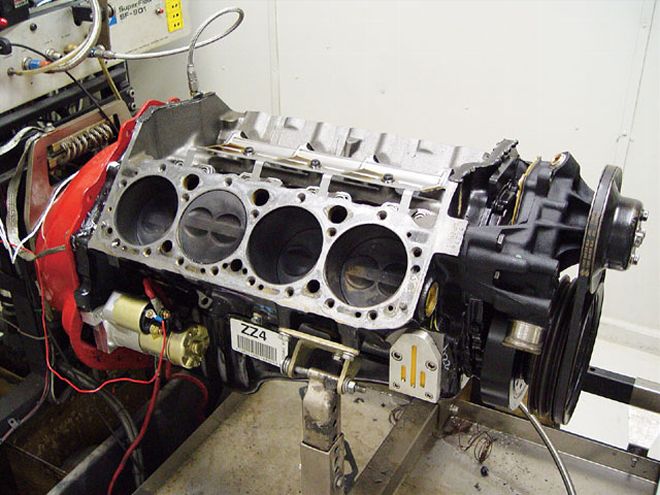 The ZZ4 long-block was untouched during our procedure, with the exception of the installation of the Thumpr camshafts.
The ZZ4 long-block was untouched during our procedure, with the exception of the installation of the Thumpr camshafts.
Thumpr Cam Considerations
The Thumpr hydraulic roller cam series from COMP represents state-of-the-art technology with regard to camshaft lobe design and overall timing. But there are a few more things worth considering for your specific vehicle combination. When using the Thumpr camshafts, especially the larger Mutha Thumpr (PN 12-601-8), it's recommended that a 3.55:1 ratio rear gearing and 2,800-plus rpm stall converter be employed to help off-the-line acceleration. With the basic Thumpr Cam (PN 12-600-8), a 2,500-plus rpm stall converter is a good idea. Remember that these camshafts will not pull as much vacuum as stock-style camshafts, so if you are running power brakes, check that you have a minimum of 16 inches of vacuum at idle, or the power assist may not function properly-a rude awakening if they fail when you need them most. On Hunkins' 496-inch big-block Chevelle, which has the Big Mutha Thumpr (same duration specs as the SBC, but with .570/.554-inch lift), there's only 7 inches of vacuum at idle at 900 rpm, but it has manual brakes. A change to the carburetor's power valve may also be necessary if idle vacuum is at or below 7 inches.
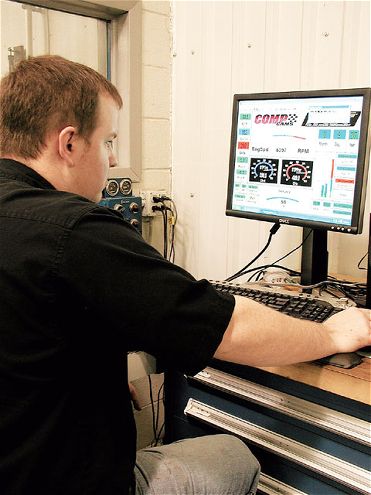 Our greatest horsepower numbers were generated with the RHS Pro Action heads, Edelbrock Air Gap intake, and Mutha Thumpr camshaft.
Our greatest horsepower numbers were generated with the RHS Pro Action heads, Edelbrock Air Gap intake, and Mutha Thumpr camshaft.
The ZZ4 Story
When GM Performance Parts decided to create the archetypical crate motor, they didn't undertake the job lightly. In turnkey crate form, it features a four-bolt block, forged steel crank, 10:1 compression hypereutectic pistons, powdered-metal connecting rods, aluminum D-port cylinder heads, dual-plane intake, Holley 770-cfm vacuum-secondary carb, hydraulic roller cam (208/221 degrees duration at .050, .474/.510-inch lift), and HEI distributor. They build the ZZ4 for durability, and at a standard you'd expect of a production car engine. The strategy of being built for longevity and reliability has worked well for GM, however the ZZ4 is far from being "on the edge" of maximum performance. As we've demonstrated, there's a lot more potential lurking in the ZZ4. The five stages seen here are great for the ZZ4 owner who's ready for that next step, as well as someone considering a new motor. If you are considering a new ZZ4, you might want to consider a partial engine assembly, which leaves off the heads, intake, timing cover, water pump, HEI, camshaft, lifters, and carb. A quick look at the Jeg's catalog shows the partial ZZ4 assembly at $2,294.99 (PN 809-12561723) versus the complete turnkey ZZ4 at $4,849.99 (PN 809-12499712). That's a savings of $2,555. You'll still need the roller lifters, intake, carb (we used the dyno's higher priced 650-cfm Race Demon), ignition, timing gear, and water pump-figure about $1,250 for pieces comparable to the ZZ4's-and you've realized a net savings of about $1,300 over the turnkey ZZ4.
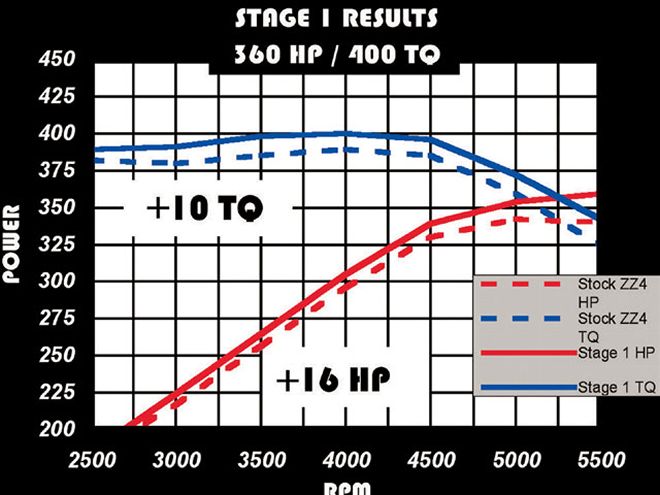
Stage 1
Peak Power: 360 hp
Increase: 16 hp
What We Did: Swapped the 1.50 ratio ZZ4 rockers for COMP Pro Magnum 1.52 rockers on the intake, put 1.60 ratio rockers on the exhaust, and swapped the stock pushrods for stronger Magnum pushrods. That's it. Stages 2-5 require both mods.
The Parts: Pro Magnum 1.52 ratio rocker arms (exh.) 249-1301-8 $171.99 Pro Magnum 1.60 ratio rocker arms (int.) 249-1305-8 $171.99 Magnum pushrods* 249-7608-16 $117.99 Total: $461.97
*Always measure pushrod length for your application.
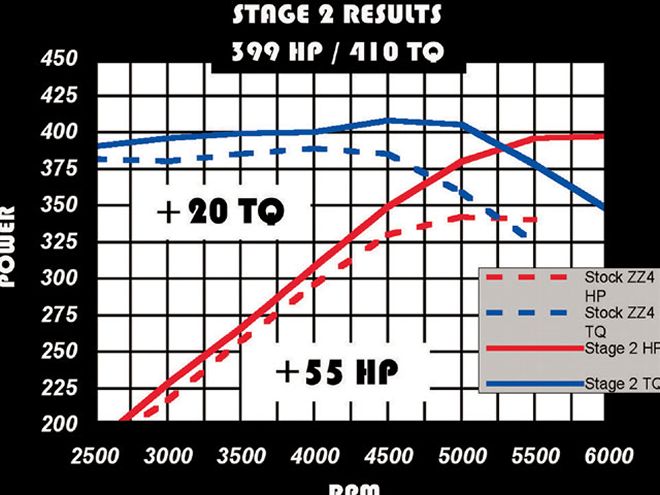
Stage 2
Peak Power: 399 hp
Increase: 55 hp
What We Did: Pulled out the ZZ4's hydraulic roller cam (208/221 duration at .050, .474/.510-inch lift), and substituted the smallest of the three COMP Thumpr cams. Removed the ZZ4 dual-plane intake and substituted an Edelbrock Air Gap. Removed the ZZ4's valvesprings and substituted COMP Beehive units. Rocker arms are still Pro Magnum 1.52/1.60 ratio units with Magnum pushrods.
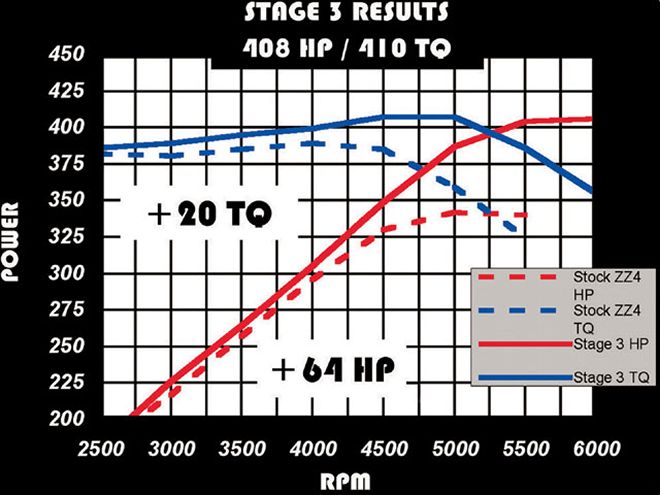
Stage 3
Peak Power: 408 hp
Increase: 64 hp
What We Did: Pulled out the smallest Thumpr cam, and substituted the mid-sized Thumpr cam, which has longer duration. This was worth an additional 9 peak horsepower over the small Thumpr. This stage basically represents a camshaft comparison between the two different Thumpr cams, so the price remains the same.
The Parts: Mutha Thumpr camshaft, 235/249 @ .050,
.521/.507-inch lift, 107 LSA 249-12-601-8 $299.99 Beehive valvesprings 249-26918-16 $189.99 Steel retainers 249-787-16 $63.99 Edelbrock Air Gap intake 350-7501 $211.99 Subtotal: $765.96 Stage 1: $461.97 Total: $1,227.93
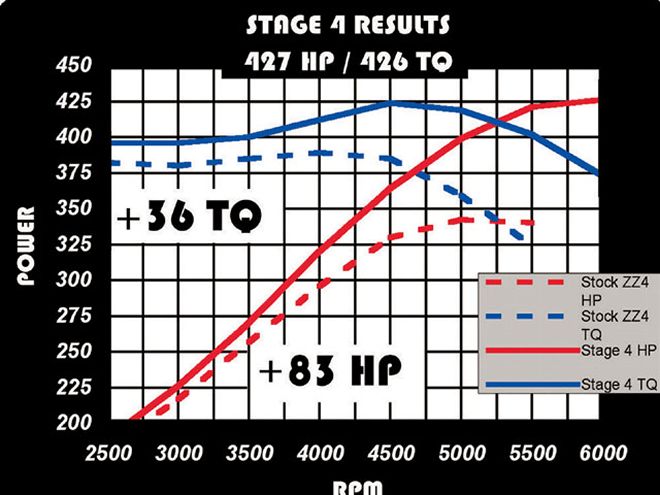
Stage 4
Peak Power: 427 hp
Increase: 83 hp
What We Did: We chucked the ZZ4's aluminum heads, and bolted on a set of Racing Head Service cast-iron Pro Action heads with 2.02/1.60-inch valves, which come assembled from RHS with the same Beehive springs used in the previous two tests. The small Thumpr cam was put back in, so the easiest comparison of this test is with Stage 2, which shows the difference in cylinder heads. The result of the cylinder head swap (using the same cam as Stage 2) is a gain of 28 peak horsepower.
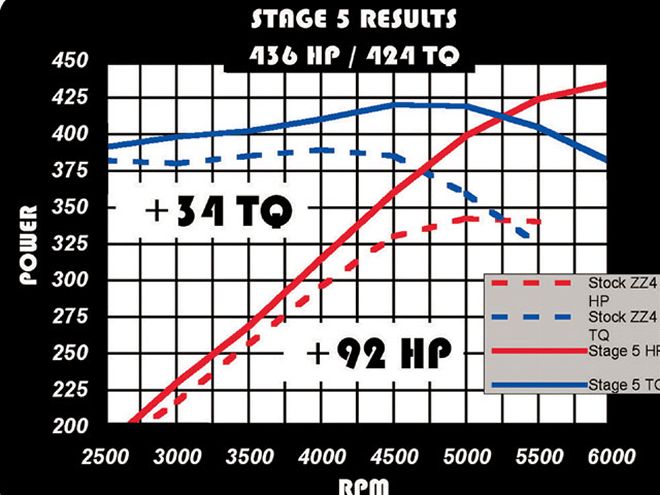
Stage 5
Peak Power: 436 hp
Increase: 92 hp
What We Did: Now it's time to throw everything in the mix. We pulled out the small Thumpr cam, and replaced it with the mid-size Thumpr, while leaving the RHS Pro Action heads and Air Gap intake in place. On the Pro Action heads, the middle Thumpr was worth 9 more peak horsepower over the baby Thumpr, which is no surprise because that's the same gain we saw when the cams were swapped on the stock ZZ4 heads. Overall, the mid-size Thumpr and the Pro Action heads were worth 92 more peak horsepower over the stock ZZ4, which was no slouch to start with. If you figure in the price of a new ZZ4 partial assembly (see sidebar) along with a comparable intake, carb, roller lifters, ignition, timing gear, and water pump, you'd have roughly $5,600 into this combo.